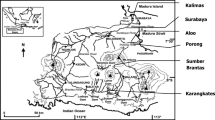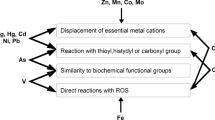Abstract
The polychaete Sabella spallanzanii (Gmelin) (Sabellidae) is a widely distributed species throughout the Mediterranean where it is commonly found in sheltered shallow areas and up to 30 m depth in more exposed waters. The sedentary habit, the filter-feeding behavior and its capability to colonize disturbed environments such as harbors, suggest the potential utility of this organism as a bioindicator in environmental monitoring programs. The aim of this work was a preliminary characterization of S. spallanzanii, integrating chemical data on trace metal concentrations with the biochemical analysis of antioxidant defenses which play an important role in mediating responses and adaptation to stressful environmental conditions. Organisms were collected in four locations of the Adriatic and Tyrrhenian Sea, characterized by a moderate impact or influenced by organic enrichment or sulphuric emissions. Trace metal concentrations (Cd, Cr, Cu, Fe, Mn, Ni, Pb, Zn) were comparable to those of other invertebrate species and quite typical for unpolluted environments. Analyses of individual antioxidants (superoxide dismutase, catalase, glutathione peroxidases, glutathione S-transferases, glutathione reductase) were integrated with measurement of the total oxyradical scavenging capacity toward specific forms of ROS; the TOSC assay, quantifying the overall capability of a tissue to neutralize specific reactive oxygen species provide a more integrated picture of the balance between prooxidant factors and antioxidant defenses, with important indications about the role of different ROS in appearance of oxidative disease. The antioxidant profile was influenced by the different physiological functions of the analyzed tissues, namely the branchial crown, involved in filtration of large volumes of seawater, and the thorax where digestive processes occur. The analysis of antioxidant defenses revealed significant variations in polychaetes from various sampling sites suggesting the influence of specific environmental conditions like those limiting oxygen availability. Our results confirm the role of antioxidants in adaptation to stressful environmental conditions and their importance in ecotoxicological studies for the sensitivity in revealing the occurrence of biological disturbance.
Similar content being viewed by others
Author information
Authors and Affiliations
Rights and permissions
About this article
Cite this article
Bocchetti, R., Fattorini, D., Gambi, M. et al. Trace Metal Concentrations and Susceptibility to Oxidative Stress in the Polychaete Sabella spallanzanii (Gmelin) (Sabellidae): Potential Role of Antioxidants in Revealing Stressful Environmental Conditions in the Mediterranean. Arch Environ Contam Toxicol 46, 353–361 (2004). https://doi.org/10.1007/s00244-003-2300-x
Issue Date:
DOI: https://doi.org/10.1007/s00244-003-2300-x




